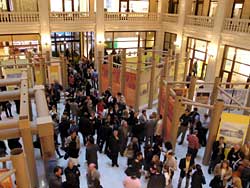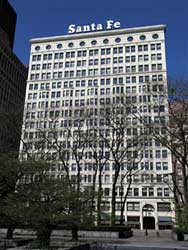

A highlight of the citywide Burnham 1909 Plan of Chicago centennial celebration, Chicago Model City includes a very large, up-to-date, detailed model of Chicago and the 3D digital computer model that was used to create the exhibition.
photo: Anne Evans
Please take time to look at the wonderful Model City and make sure to bring your children. Let’s get our young people to think early about urban planning and sustainability for our cities, just as Daniel Burnham did a century ago,” said Mayor Richard M. Daley. “Visionaries like Daniel Burnham have always looked to the future to ensure that cities maintain the resources needed to carry out sustained growth polices that ensure a high quality of life for their residents. To this day, Burnham’s vision of great plans to stir our souls resonates in our ongoing goal of making Chicago a global city and model for other cities around the world. Our architectural influence is well known worldwide. Getting people involved in the process of developing and improving our city is important to our success.
Appealing to all ages, Chicago Model City allows visitors to get up close to the model which spans four sq. miles from Lake Michigan to Halsted and from Oak Street to 16th Street. It has 1000 highly detailed buildings in 400 city blocks. The scale is 1 inch to 50 feet, making the Sears Tower nearly three feet tall! The lighting simulates June 21st, the longest day of the year, going from morning to night every 15 minutes.
Designed to get people thinking about how cities develop, the exhibition shows how Chicago is a model for understanding all cities. Chicago Model City provides information on today’s planning efforts and highlights issues such as density and the conservation of natural resources. Size, diversity, industry, and complex infrastructure have all made Chicago a good representative of modern life as well as Daniel Burnham’s Plan of Chicago in 1909.
“People who visit Chicago Model City will love it because it is so big and detailed,” said Lynn Osmond, Chicago Architecture Foundation President and CEO. “They will go home with ideas about the future of Chicago and their hometowns.”

The former Santa Fe Railway Exchange Building, 224 S. Michigan Avenue, served as Burnham’s headquarters for the creation of the 1909 Plan of Chicago. Today it is headquarters for the Chicago Architecture Foundation, making the location an ideal site for an exhibition that focuses on the future of Chicago. Special Chicago Model City programs, lectures and tours are being offered along with a family-friendly exhibition, B Like Burnham. www.architecture.org
The Chicago model will be a permanent legacy for the city. CAF has plans to enhance and expand the model, which would become the focus of its new facility, planned for 2011.
Chicago Model City has five sections.
Beautiful City: Chicagoans’ efforts to build an efficient, pleasurable, and moral environment through beautification, exploring Burnham and Bennett’s 1909 Plan of Chicago and proposals to remake Chicago for the 2016 Olympic Games.
Global City: How transportation networks form the basis of Chicago’s economic wealth and innovative potential, including O’Hare Airport and freight railways.
Connected City: Chicagoans’ ability to travel throughout the region encourages urban growth; drives real estate development; and contributes to quality of life.
Green City: The impact of urbanization on health including Mayor Daley’s Chicago Climate Action Plan and Jane Addams’ public heath initiatives.
New City: Whether or not demolition and rebuilding solves urban problems. An example is the IIT campus—which was “renewed” in the 1940s.
Architects, model makers and industrial designers created the perfectly formed replica of Chicago’s downtown for the exhibition. Corporations like DSM Desotech, Baxter International Inc. and Molex Incorporated worked with Columbian Model & Exhibit Works by donating staff, technology, materials, and time to make a scale model of Chicago come alive. Rather than creating each building by hand, the model was made using a cutting-edge rapid prototyping manufacturing process called stereolithography.
Leading support was provided by Baxter International Inc., DSM Desotech, Illinois Department of Commerce and Economic Opportunity / Bureau of Tourism, Allstate Corporation, Bank of America, The Burnham Plan Centennial, Feldco, Molex Incorporated, Searle Funds at The Chicago Community Trust, and Structural Engineers Association of Illinois. Additional support was provided by Altman Lighting, Chicago Bears Football Club, Chicago Sun-Times, Color Kinetics, HOK, Intelligent Lighting Creations, Inc., Illinois Section of the American Society of Civil Engineers, Lightswitch Architectural, Skidmore, Owings & Merrill LLP, and Zumtobel Lighting, Inc.
The Chicago Architecture Foundation (CAF) is a nonprofit organization dedicated to advancing public interest and education in architecture and design. The Chicago Architecture Foundation pursues this mission through architecture tours, exhibitions, panel discussions, and youth and adult education programs. Home to a permanent exhibition: CHICAGO YOU ARE HERE, the Chicago Architecture Foundation is located at 224 South Michigan Avenue, Chicago, Illinois 60604.
For further information visit www.architecture.org
or call 312.922.3432.
